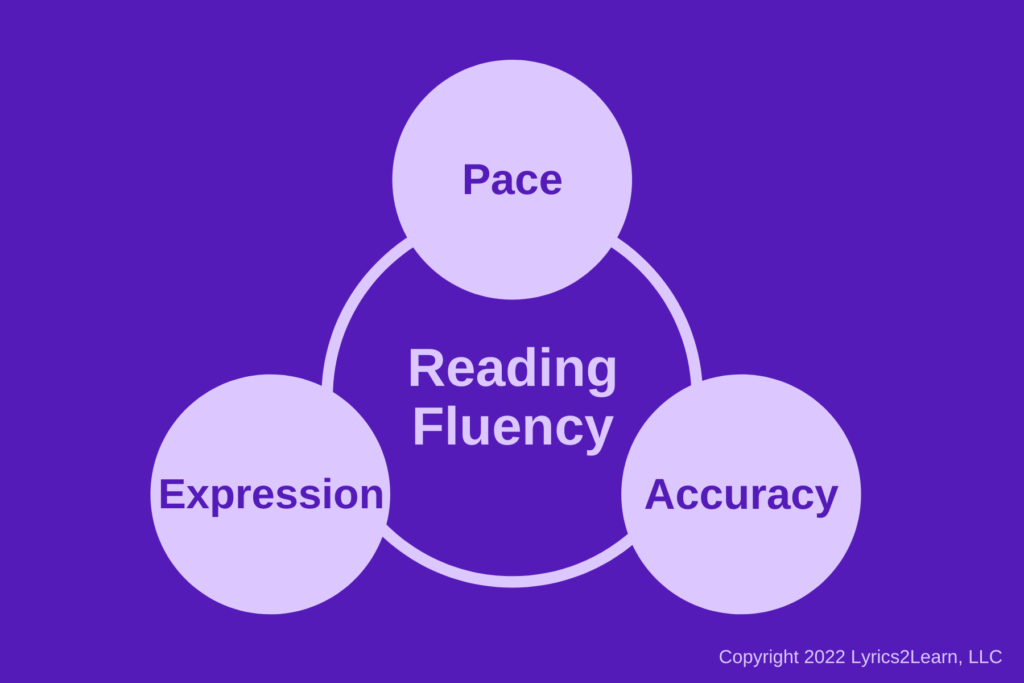Reading Fluency, an Essential Reading Component Often Neglected

What is reading fluency?
Fluent readers read text smoothly, accurately, and with expression–fluency isn’t necessarily fast rapid reading. We’re looking for smooth, expressive, and engaging reading.
When my students read smoothly, clearly, and expressive enough to provoke emotion, chances are exceptional that they also comprehend on a high level. They may still need to develop more background knowledge or be guided through higher-level thinking, but that is approached with its own set of research-based instructional strategies. Bottom line, reading fluency is an independent component of reading measured in three ways:
- Pace – the rate at which one reads, often measured in words per minute (WPM)
- Accuracy – correct vs. incorrect word pronunciation
- Expression – reading with appropriate tone, pitch, pause, and inflection

Is Fluency Instruction Aligned with the Science of Reading (SOR)?
100%–yes!
The research from the last 40+ years is irrefutable. Reading fluency is essential, and as its own component of reading, needs to be taught separately. There are five components of reading; phonemic awareness, phonics, vocabulary, fluency, and comprehension. Each component has separate instructional strategies. A student that is strong in phonemic awareness and phonics, both essential foundations to becoming a successful reader, may not actually be a fluent or comprehending reader.
Science of Reading (SOR) Resources we LOVE!
My favorite and most reliable research resources come from two Tims; Timothy Shanahan and Timothy Rasinski. Timothy Shanahan served on the National Reading Panel and is a no-nonsense, well-versed lifetime educator who is all about, and only about, the research. View his blog here. I reference and post his articles often. Tim Rasinski, also a lifetime educator and cited often on Lyrics2Learn, was awarded the William S. Gray Citation of Merit—the highest honor bestowed on a researcher by the International Literacy Association (ILA). Additionally, Stanford University places him in the top 2% of scientists in the world. View his blog here.
The most comprehensive independent review, conducted by the National Reading Panel, examined thousands of research studies on effective educational reading strategies. Here’s what they said about the importance of fluency:
“Are guided repeated oral reading procedures effective in improving reading fluency and overall reading achievement? The answer was a clear yes. The analysis of guided oral reading procedures led to the conclusion that such procedures had a consistent, and positive impact on word recognition, fluency, and comprehension as measured by a variety of test instruments and at a range of grade levels.” (pg. 191)
National Reading Panel (NRP, pg. 191)
So, “can fluency be encouraged through instructional procedures?”
Yes!
An extensive review of the literature indicates that classroom practices that encourage repeated oral reading with feedback and guidance lead to meaningful improvements in reading expertise for students, “for good readers as well as those who are experiencing difficulties.” It goes on to say, “children who do not develop reading fluency, no matter how bright they are, will continue to read slowly and with great effort” (NRP, pg. 191).
Three Proven Reading Fluency Strategies
Repeated Reading (RR)
Just as it sounds, repeated reading involves reading the same passage several times over. The first reading, often called the “cold read,” is the most difficult, and each subsequent reading after becomes less laborious for the reader. It is important to note that this should not be done silently. Effective repeated reading involves oral, out-loud repetition, preferably with some form of accountability, be it in peer reading with partners, video recording the reading of a passage, or teacher-guided repeated reading one-on-one.
Repeated Reading with Lyrics2Learn
On Lyrics2Learn, we can automatically record the student’s first attempt, also called a cold read. The student then reads repeatedly throughout the week until mastery is achieved. As they read repeatedly to rhythm and rhyme (much more fun, engaging, and memorable than the traditional repeated reading of static text), they retain a high percentage of the information, developing background knowledge of the content.
Students also answer comprehension questions that increase in complexity each day. By day 3 of our program, they have mastered the story. If not, they can practice as many times as needed before submitting their final video to the teacher or parent. We then record and send their “hot read” to the parent or teacher running the account. Teachers or parents can watch and grade the fluency and kids see how a little practice can lead to a huge success! It’s more fun, more engaging, more memorable, more effective, and uses the science of reading strategies proven to work.
Choral Reading
Choral reading is used in many classrooms and involves multiple people reading the same selection out loud, in unison. This creates a level of comfort, ensures everyone is actively engaged and utilizes multiple senses. Students hear, see, and speak what they read simultaneously together. If they do not recognize a word they will hear it read by others, like an automatic self-correction in your ear 🙂 Not coincidently, this is the concept of modeled reading.
Modeled Reading
Modeled reading involves the student reading aloud with a teacher or educator present. Many teachers approach this in different ways. Some use metacognitive strategies, or verbally think through strategies (out loud for the student) that are being used to decode words, comprehend the meaning, and read with pace, accuracy, and expression. Others read aloud with the student modeling expression, helping with self-correction, and guiding a student through a passage. The benefit of modeled reading is the feedback provided specifically to the needs of the student.
How do you tie all three strategies together?
Lyrics2Learn incorporates repeated, modeled, and choral reading with every lesson and in a variety of ways. Each student repeatedly reads along with a musician who models expression, accuracy, and pace. Students also apply what they have learned through leveled and scaffolded comprehension activities after each fluency practice session.
Most importantly, through Lyrics2Learn, students can control their own learning. They can practice as much as they would like before sending their hot read to the teacher. This is powerful and allows the student ownership of their success. Teachers can view a student’s cold and hot read recordings, send individualized feedback to the student, and share the video with parents or guardians with the click of a button.
The Problem for Teachers
Coming from the classroom, I can tell you that making time for daily, one-on-one, or small group fluency practice with each student is beyond impossible. There are too many requirements and not enough time in the day. The good news is that, with a little help, this essential component of reading can be supplemented in fun, effective and research-based ways that are low impact on teachers.

Jeremy Spartz
Former Teacher, Founder, and CEO of Lyrics2Learn
Jeremy taught 2nd and 4th grades for 14 years while tutoring, testing, and piloting research-based reading strategies. As a teacher, he grew a school-wide poetry slam to include 180 students performing original poetry and developed the Lyrics2Learn curriculum. He loves writing, reading, all things outdoors, sports, art, and anything that focuses on constant improvement and positive impact.
